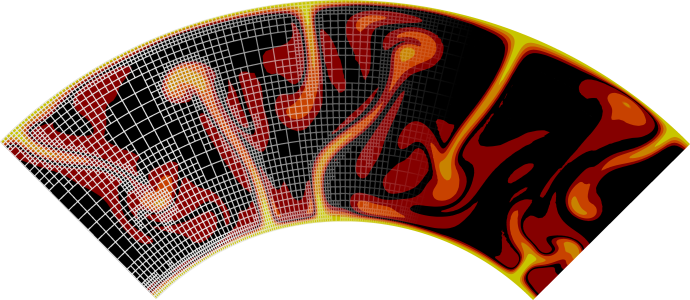Heating models#
The heating model is responsible for describing the various terms in the energy equation (3), using the coefficients provided by the material model. These can be source terms such as radiogenic heat production or shear heating, they can be terms on the left-hand side of the equation, such as part of the latent heating terms, or they can be heating processes related to reactions. Each of these terms is described by a “heating model,” and a simulation can have none, one, or many heating models that are active throughout a simulation, with each heating model usually only implementing the terms for one specific heating process. One can then decide in the input file which heating processes should be included in the computation by providing a list of heating models in the input file.
When the equations are assembled and solved, the heating terms from all heating models used in the computation are added up.
To implement a new heating model, you need to overload the
aspect::HeatingModel::Interface
class and use the ASPECT_REGISTER_HEATING_MODEL macro to register your new class. The
implementation of the new class should be in namespace aspect::HeatingModel.
The functions you need to overload are extensively
discussed in the documentation of this interface class at
aspect::HeatingModel::Interface.
The main properties of the material are computed in the function evaluate()
that takes references to MaterialModelInputs and MaterialModelOutputs
objects and is supposed to fill the HeatingModelOutputs structure. As in the
material model, this function is handling lookups at an arbitrary number of
positions, so for each heating term (for example the heating source terms), a
std::vector is returned.
Heating source terms are terms on the right-hand side of the equations, such
as the adiabatic heating \(\alpha T \left( \mathbf u \cdot \nabla p \right)\) in
equation (3). An example for a left-hand side heating term
is the temperature-derivative term
\(\rho T \Delta S \frac{\partial X}{\partial T}\) that is part of latent heat
production (see equation (5)).[1] Rates of
temperature change[2] are used when the heating term is related to a reaction
process, happening on a faster time scale than the temperature advection. All
of these terms can depend on any of the material model inputs or outputs.
Implementations of evaluate() may of course choose to ignore dependencies on
any of these arguments.
The remaining functions that need to be implemented are used in postprocessing as well as handling run-time parameters. The exact meaning of these member functions is documented in the aspect::HeatingModel::Interface class documentation. Some of the functions listed have a default implementation, as discussed on the documentation page just mentioned.
Just like for material models, the functions initialize() and update() can
be implemented if desired (the default implementation does nothing) and are
useful if the heating model has an internal state. The function initialize()
is called once during the initialization of
ASPECT and can be used to allocate memory for the
heating model, initialize state, or read information from an external file.
The function update() is called at the beginning of every time step.

